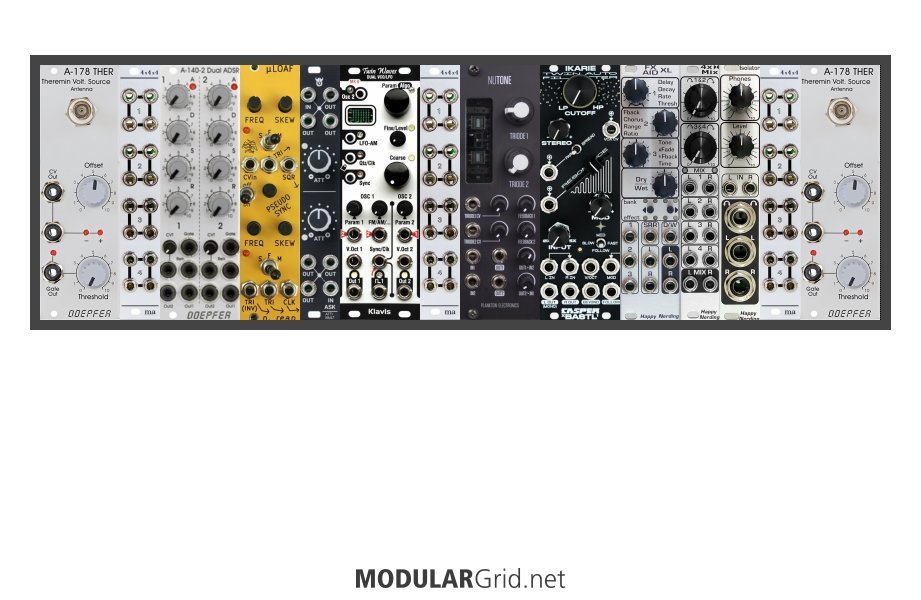No, it would be a single voice...you've got one aerial for pitch (closer = higher) and the other for level (closer = quieter, with touching this aerial acting as a "mute"). Or at least, that's how it SHOULD be. I worked for years with a Maestro unit (one of Tom Oberheim's designs...NOT Bob Moog, since that unit came out in the pre-Norlin period) that had an amplitude implementation which worked "backwards": get closer, it gets LOUDER, and "muting" wasn't possible at all. Finally sold it for a pile of money, got a Moog Theremini instead which offers more connectivity, a far better sound module, etc.
My concern here is that the case might not be wide enough. Those aerials need some distance so that you're not accidentally changing pitch when you need volume changes, and vice-versa. A 1 x 84 would probably work better here...sort of like...wait for it...

OK, there we GO...width is now 84 hp, which keeps the aerials further apart AND which allows for some trickery.
You'll notice that this seems to violate one of my own rules, namely that mults don't belong in small builds. However, given that this ISN'T a "proper" synth and that this really NEEDS them to distribute various signals in parallel, there's three (technically, four) of them to help with that. Two are at the obvious places, to distribute the various aerial signals. The others make sense when you look at the signal flow...
SO, after the amplitude (left) aerial and its mults, you've got a pair of ADSR envelopes which get gated via the left aerial. Then there's one of Noise Reap's weird dual LFOs which has some capabilities for scrambling its OWN operation for weird, non-symmetrical modulation curve outputs. After that is a Bragi ASK, which provides two attenuverters with 3-way multed outs for altering modulation signals and distributing them to various destinations.
For the oscillator, I opted for a Twin Waves mkii, which gives you two oscillators, several useful internal routings, and a quantizer which allows you to play discrete steps in addition to the typical theremin glissandi. Another mult after that lets you distribute the oscillator outs to the various audio processing modules that are placed just after it. Mind you, you don't HAVE to use the mult there; it's just as valid to patch those in a post-VCA configuration...especially given the VCAs in question. I went with one of Plankton's dual VCAs that use a NuTube triode which you can slam the crap out of for some distortion/waveshaping.
And since we're definitely now in stereo, the VCF I chose was Bastl's Ikarie, a very odd and somewhat nasty stereo filter that can behave...or get really gritty, plus it has a dual-peak architecture so that you can have some similarly-tracking but different-sounding filter responses in its two channels. Then, effects...theremins are awesome with some processing, so I opted for Happy Nerding's excellent FX Aid XL for a useful effects "library". Then past that, I put in a HN 4x Stereo Mix...this lets you deal with the stereo outs of the VCO, VCA, VCF, FX Aid...however you want to deal with them in parallel so that you can have sound events that involve the sound "evolving" between those modules via some judicious patching of the various modulation bits. Lastly, the HN Isolator is a MUST here, since you're dealing with RF circuits and you don't want crud getting into those and destabilizing them...which is an inherent issue with theremins, and why many of the cheap ones sound like total ass. Then mult, pitch aerial, and there you go!
As for aerial placement, that'll vary a lot depending on how you feel comfortable with interfacing with the aerials. In theory, you can keep the amplitude aerial partly un-telescoped and aimed sideways so that you've got something with some similar ergonomics to the RCA and Moog designs. Pitch aerial definitely goes straight-up and at full extension, though. And remember to keep this away from metal surfaces which will couple with the RF controllers and cause various control annoyances.
